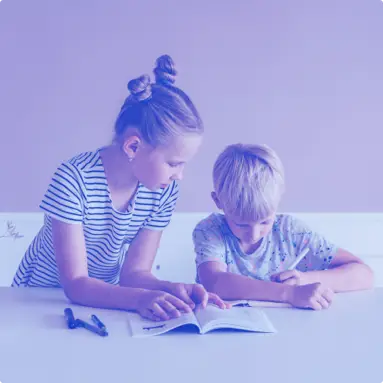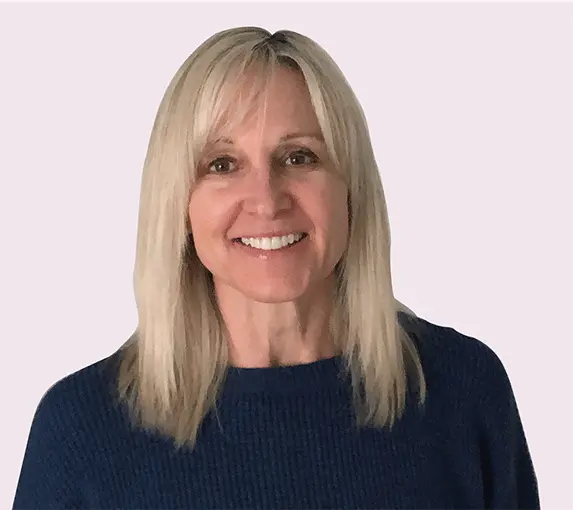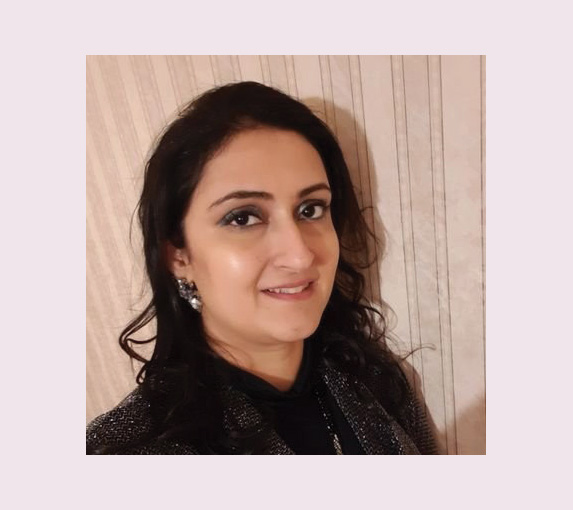
Episode 132: Textbook sceptic? How and why textbooks elevate learning
Colourful visuals, Tea-sipping teachers, and more. In this episode, Robin and Adam are joined by Sana Malik to discuss how textbooks bring maths learning to life and help all pupils. Do other countries use them? Why do people have a negative perception of them? Plus, Sana speaks on the textbooks characters growing throughout the book and assisting children on their maths journey through school.
More Podcasts on Education
Continue listening to our educational experts
Meet your instructors
The school of school podcast is presented by:

Andy Psarianos
@andy_psarianos

Adam Gifford

Robin Potter
Special guest instructor

Sana Malik
Never miss an episode
Subscribe to get the latest The School of School podcasts delivered to your inbox.
Podcast Transcription
Andy Psarianos
Hi, I'm Andy Psarianos.
Robin Potter
Hi, I'm Robin Potter.
Adam Gifford
Hi, I'm Adam Gifford.
Andy Psarianos
This is the School of School podcast.
Welcome to the School of School podcast.
Robin Potter
Welcome back to another episode of The School of School podcast. I am joined by one of our usual suspects, Adam Gifford. Hi, Adam.
Adam Gifford
Hey, Robin.
Robin Potter
And we also have a special guest today, Sana Malik. Welcome, and please tell us a little bit about yourself.
Sana Malik
Hi. I'm Sana Malik. I am from St. Mary's Primary School in Manchester and I am currently teaching year five. I've been teaching for nine years and I'm also the maths lead of the school.
Robin Potter
Fantastic. Well, we have you here today because you seem to know a lot about lesson structure, and I'm just curious if you could tell us a little bit more about the textbooks and how you use the textbooks effectively in a lesson.
Sana Malik
So, yes, I think before I just talk about the textbooks, it's important to understand what's happening before, looking at the textbook. So of course the textbooks are there for the teachers to see where the lesson is, and that gives the teachers a chance where to take the class, where to ask this questions, where to pause, get them to really focus. But before that, of course, as in a lesson structure, children have already had the chance to explore the task, spoken to their peers, their partners, their teams, have already used pictures, models, concrete resources, lots of talking, teacher structuring. So that has already happened in the lesson before, which they have done. So they've had the chance to look at the models and everything. That is what your friend has done, child A, child B.
The teacher has of course done the structuring, structured discussions about what's happening. At that time, of course, we also do journaling as well. Teachers sometimes use that. Journaling can be done at any point. So sometimes after looking at the textbooks or before. So I'm just going to now, in terms of textbooks, I think it's very important that children really benefit from using textbooks because then actually children already have the experience of solving the problem and it makes them really proud of themselves when they see the textbook and then they see, "Oh, this was a problem. This is how the experts, the textbooks, are doing it, and this is what we did. So this is very similar to our problem."
So, can you see what models is the book showing? Can you see the pictures they're drawing? Can you see the methods you're using? Is it similar to what we did in the class? Yes. Charlie did that one. Well done. So we are very clever. We can do this. We are brilliant. It was a clever day for us. We had more methods than the book. This method is not in the book, so we can think of more methods in the textbook. So it's like a moment of pride for the class to see. We are on the right track. We are doing the right things. We are good mathematicians here. And then of course further enhancing and deepening their understanding of the concept. So I do see sometimes that children, when they actually look at the textbook, because it's very carefully designed, they research the problems, the models, the visuals, the textbooks are very...
One of the children, actually, I must say, I did here before I forget that, one of my past pupils came to our school and I asked him this question about, and they said, "They were so colourful, Miss, the books were so colourful. They had so many pictures." And that was a child who came from a high school, and I just thought, "He remembers that." So that just explains how many visuals and how many pictures and so much they enjoy looking at the book and they understand the concept even more when they see those pictures. And where the CPA approach is very carefully followed in the books like the concrete resources, links to the picture, links to the number in the method. That's my abstract method. This says what I can show it like. This is how I used it in the class, or this is what the book is showing.
So it really gives the chances to children who are actually using the concrete only, they were on that stage, to now then see, "Okay, now I can see how these pictures or these models links to this equation or this question or these numbers in an equation." So they can make those links. And teachers, it is a very useful resource for a teacher definitely, because then you can say, "Okay, let's look at the master part of what is the book showing? What methods? Can I ask everybody to look at number one now? Can you look at this one? Can you explain to your partner why is this child doing this?" Because you have children in the book, which they're so used to of looking at Hannah is doing this and they can talk about Elliot.
So they relate to those characters as well. And in a way, the books, because they've been looking at those characters since year one and the characters are growing with them, so it's like a journey. They have been in a maths journey, they have been on together. But you see that. So the book is of course a resource for a teacher to really pick on those elements like fluency, like generalisation. Can you see any pattern in this problem? Can you look at this picture? Can you see a pattern? So you can really facilitate all those key elements of the lessons that we want the children to be using, like visualisation, generalisation, pictures, models. And you get them to do a pause and reflect. Can somebody explain?
And then there will be one child who wants to talk to everybody, or if they have a question, "I don't understand what this child is saying." So it is really definitely a very good resource for children and for teachers. So to have further deep understanding of a concept and that moment, sometimes a light but more for children who have not actually made progress so far, they have, I believe, every child make progress in every part, but depending on which part they are on, they definitely say, "Well, I understand that now. This is this, and this is that." So, yeah, the textbook is a very useful resource in many ways for teachers and for children.
Adam Gifford
Can I ask a question, because I've got skin in the game, right? So textbooks, live and breathe them and we work with them for years and a long time, a long time, so I know them pretty well. I guess my question to both of you, because you're both familiar with the books and you've both been to school, so that's good. Why have people got a problem with textbooks? Why is it that, I don't know, there's a sense of textbook's bad. What's that about? Does anyone want to hazard a guess as to why they're there. And with some people in some quarters there's this sort of anti-textbook. What you've just described, Sana, and I know the benefit of them, and not just me. It's not anecdotal. I mean, there's hard evidence, but what are your thoughts on that? Why is it people sometimes are sort of sceptical of using-
Robin Potter
Maybe before Sana gets into it, a brief thought of my own childhood maths experience with textbooks. First of all, I don't really remember any of them specifically, Adam, and that may be a cue because they were just filled with a bunch of questions and maybe formulas or just boring. Can we say it that way? I mean, nothing that would have given me excitement to learn more or... There was no colour, there were no characters, there was no white space. Anyway, I guess the point is, the textbooks for maths is no problem. In my experience, that's just night and day. That's just a completely different experience for students and it wasn't one that I had.
Adam Gifford
So just picking up on that point, Robin, just before we hand over to Sana, I think that's a really good point. I think that if I remember back to the textbooks that I had, and maths was really easy, I think. I often wondered to myself whether this is the reason why I became a teacher, because it looked really easy and it looked like a job that I could just... I had a teacher that basically what would do is he'd just walk into the class and they'd have the page numbers that you need to work on.
Robin Potter
Right.
Adam Gifford
And you got your textbook out and he just sat there and drank cups of tea. And I looked at him and I thought, "That's the job for me, man. This is easy. All I have to do is put some numbers on the board and kick back. This is excellent."
Robin Potter
Yeah, turn to page 12. There you go.
Adam Gifford
But I think you're right. I think what you've described is the final step, the kind of abstract step where you've got your numbers and symbols and all that sort of stuff. But certainly what was missing in my textbook, and this must have been so difficult for people who just didn't understand it or didn't have that prerequisite knowledge of it, there was nothing in the book that you could look at that when you were screaming inside, "Help," there was nothing that gave you a heads-up to say, "Use these. Get some counters out. Make this. Do that. This is what relates to this."
It was a guess. I think that that's one thing that I think that is a really important lesson to learn today. Good maths books, good textbooks are sophisticated and when we choose them we should be equally as sophisticated. So I think that's really interesting that you've brought that up, Robin. Sana, what about you? What about you? Where's this anti-textbook sentiment? Where's it come from? Going to? How do we combat it?
Sana Malik
I definitely, I think will second that, what you both said about the experience of textbooks. When we had textbooks, definitely not as visuals. Definitely boring, just telling us a method and do these questions, set of 10 question, you feel really proud if you've done them all. First person to do it gets this. So it's always like that. You had the pressure of I have to do these questions, but now it's more that they have the connections with the book, they understand, they look, the visual models, as I said before, the concrete pictorial abstract for children to see that, very important, because as we said, they are different learners, they have different learning styles.
And the book really clearly shows each style making the link to how we link, how do we link the abstract methods to the concrete and pictorials representation. And that's the model for them. That's like you show them those models, the right models that they should be using, and that's of course a step on in terms of your learning experience that you see that, you look at it, you make the further connections. And I don't understand why a teacher or a child wouldn't benefit from using a textbook. It could be seen as like, "Okay, we've taught them, we've done this, why do we need textbook?" But I think it's a very important part of the lesson for both teachers and children.
Adam Gifford
When you look at international studies, I think sometimes people might misread those in thinking it's about the high attainment levels, but the number that we should be looking at, to me anyway, the numbers that are most important in international studies is the proportion of children who are able to problem-solve, who are able to show problem-solving skills. And it happens to be maths as the vehicle for that in some of these assessments. And I think what have all of these top performing jurisdictions got in common? And one of the things that they have in common that they couldn't imagine teaching without, is a high quality, well-structured, well-thought-out textbook.
Sana Malik
Definitely.
Adam Gifford
So I do find it bizarre, but then I think that possibly it's a hangover from poor textbooks that were delivered like they were delivered to me, which was simply-
Sana Malik
Wasn't helpful.
Adam Gifford
... you do that, you open your books, away you go. Do pages 19 to 23. When you finished, silent read.
Robin Potter
Right. Let me finish my tea.
Adam Gifford
That was the approach. Yeah, of course, of course. It was awesome. I got so shortchanged, because teaching's really hard work. I was gutted.
Robin Potter
Surprise.
Sana Malik
I don't remember those visual models. I don't remember. I just remember the name of the topic. Lots of reading, bizarrely, on the maths book. Lots of different things solved. And then you had to use that matter to solve another 10 more problems. So it was never like a moment which I enjoyed that I'll be looking at the book now. But I do see children enjoying it now.
Adam Gifford
Yeah, totally. But I think the thing too is that what we've learned from countries that have used textbooks and got to a point where it's not just using a textbook, but it's actually saying that the only textbooks that you can use in the classroom have to have these features, right? Because I think that's the other thing that I struggle with massively. This isn't unique to the UK. I've been to other countries where this is true, certainly my home country, New Zealand, it's true there, is it's kind of in places that don't use textbooks.
The question that I always ask, and I get a very mumbled, almost like a politician's answer that circles around the actual answering of the question, which is, "Well, what do you do then? What do you use in its place?" Like, if you are not using that, if you're not using a book, and we use a book to learn every single subject, books are used for every single subject, right? If you're not going to use a book for this, what do you use? And then there's a mumbled answer or whatever. But most people, if they're being completely honest, "I get something off the internet." Well, how do you know it's well written? "Well, I don't. I just get something off the internet because at the moment we're doing equivalent fractions in year three, so I type into Google year three equivalent fractions, and I get myself a printable." Now, it's chance, right? It's chance whether they're good or not. It's chance.
Sana Malik
Yeah. And you cannot take the risk.
Adam Gifford
No. And so, I don't know, I think that people need to be very careful if they just think, "Well, there are so many alternatives out there," because actually are there. Because if you write a problem, it takes ages. You could produce a really badly written worksheet in a heartbeat, but if you really want to support a child to learn that particular idea on that particular day to ensure that 30 children can access it, that the teacher can talk to it, that it builds on previous lessons, that's a whole different ballgame. That is totally different. And I think what would be awesome is if teachers could spend time with people who write textbooks and start to see the inner workings of it and what happens and the process that it goes through and all of those sorts of things, because it's very different-
Sana Malik
Definitely. And the progression.
Adam Gifford
... in some circumstances to just print them.
Sana Malik
Yeah. And the progression of the lessons, because always building off from the previous learning, previous lesson, there's always a step that's added and where again, well-researched has to be well-thought of.
Robin Potter
Yeah.
Adam Gifford
Yeah.
Robin Potter
And then moving into the next year, it's the same thing. It's a progression and it's familiar then to the students. They're already familiar with. And again, going back to our textbooks, we do have characters that they see every year that progress with the children and get older as the children get older, and...
Sana Malik
You can get those characters' name wrong, but they will never get it wrong. They will correct you. It's like, "Oh, gosh, sorry. Yes." So they know exactly what the names are. They don't have to be reminded. And I can make those mistakes. They have never made it.
Robin Potter
Wow.
Adam Gifford
But I think the other thing too is that even things like that, so the children will see them as something, like your student that came back and saw you, Sana, and talked about the fact that they're colourful and fun and you get to know their names and it's almost like you grow up with these kids. But if I am going to wear my part of the textbook team hat, is that the use of those characters supports metacognition. Now we don't expect the children to know that, but there's no fluff to it. So they're not in there just to look pretty. Now that might be the impression people take away and that's fine. That is absolutely fine. But I think that's the other thing that we need to be mindful of, is that these aren't illustrations for illustration's sake.
That these have a really important part to play, and children get used to the types of questions and the way that the characters think in the book. So it's really interesting. The more that you find out about it, the more it leads to specific elements of learning within a lesson that support the child's learning. And I think that's the thing. I think that when you start to understand those elements, I couldn't imagine teaching without a textbook now. I'd feel like I'm missing an arm. It would be really, really difficult because I'd know that the supports that children need in order to learn really well has been taken away from them.
Sana Malik
It's the language as well.
Adam Gifford
And I really-
Sana Malik
The language, the use of language, the sentence structures, how do we explain that? What are the concepts? The characters, also, not always getting it right. We have many times those characters in the book, they have a misconception as well, so gives the children's a chance what the misconception was, where was Elliot wrong? Who is right? And how do you know? So there's always, they make this connections. And of course to then look at the textbook, it gives them a chance to explain their ideas and to articulate and explain and reason.
Adam Gifford
Well, I hope we've convinced at least one person. If you're listening and you're a sceptic about textbooks, all I ask is this. You don't have to go away and start using them straight away. Or if you do, I'd say it's a smart move as long as you pick the right one. But be curious. Why is it that so many schools that do well, Sana's school does incredibly well, and international jurisdictions, why is it that there's this common thread with textbooks? All I would ask you as an educator is be curious about that because surely what you want is to be able to support the largest proportion of children in your school to the highest level. And research would suggest to us very, very strongly that a textbook is an element that's needed in order to do that. So-
Sana Malik
Definitely. Definitely.
Adam Gifford
... be curious. Yeah.
Robin Potter
Sana, thanks so much for joining us today.
Sana Malik
Thank you. It's my pleasure.
Andy Psarianos
Thank you for joining us on the School of School podcast.
More Podcasts on Education
Continue listening to our educational experts
